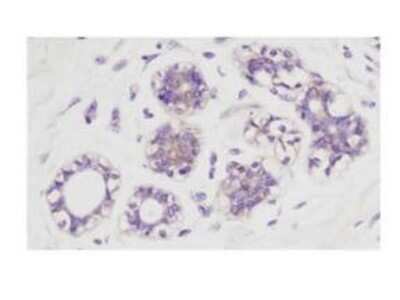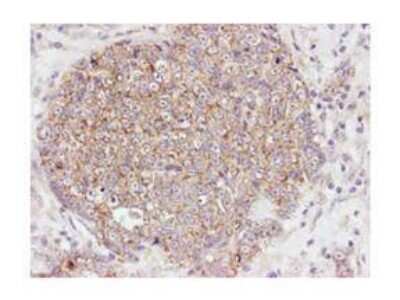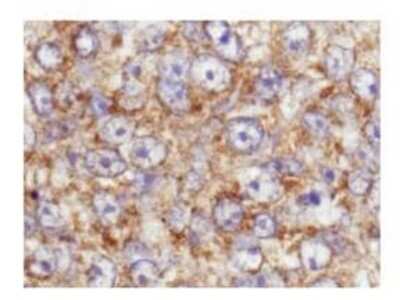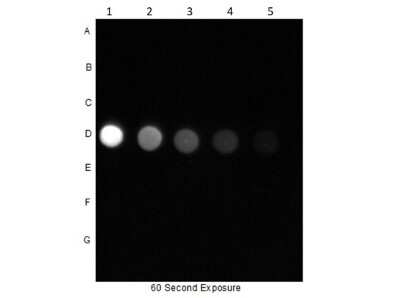AKT1 [p Ser473] Antibody - BSA Free
Novus Biologicals, part of Bio-Techne | Catalog # NB600-590

Key Product Details
Validated by
Biological Validation
Species Reactivity
Validated:
Human, Mouse, Rat
Cited:
Human
Applications
Validated:
Dot Blot, ELISA, Immunocytochemistry/ Immunofluorescence, Immunohistochemistry, Immunohistochemistry-Paraffin, Western Blot
Cited:
IF/IHC, Western Blot
Label
Unconjugated
Antibody Source
Polyclonal Rabbit IgG
Format
BSA Free
Concentration
Please see the vial label for concentration. If unlisted please contact technical services.
Product Specifications
Immunogen
AKT1 [p Ser473] Antibody was prepared by repeated immunizations in rabbits with a synthetic peptide corresponding to a C-terminus region near phospho Serine 473 of the human, mouse, rat and chicken AKT1 proteins conjugated to KLH. (Uniprot: P31749)
Reactivity Notes
This antibody is specific for phosphorylated human AKT1 pS473. Minimal reactivity occurs against non-phosphorylated AKT. Reactivity against AKT1 from other species may occur but has not yet been tested.
Modification
p Ser473
Localization
Cytoplasmic and Nuclear
Specificity
This antibody is specific for phosphorylated human AKTpS473. Minimal reactivity occurs against non-phosphorylated AKT. Reactivity against AKT from other species may occur but has not yet been tested.
Clonality
Polyclonal
Host
Rabbit
Isotype
IgG
Description
This product was prepared from monospecific antiserum by immunoaffinity chromatography using a phospho peptide coupled to agarose beads followed by solid phase adsorption(s) against a non-phospho peptide and non-specific peptide to remove any unwanted reactivities. Assay by immunoelectrophoresis resulted in a single precipitin arc against anti-Rabbit Serum
Store vial at -20C prior to opening. Aliquot contents and freeze at -20C or below for extended storage. Avoid cycles of freezing and thawing. Centrifuge product if not completely clear after standing at room temperature. This product is stable for several weeks at 4C as an undiluted liquid. Dilute only prior to immediate use.
Store vial at -20C prior to opening. Aliquot contents and freeze at -20C or below for extended storage. Avoid cycles of freezing and thawing. Centrifuge product if not completely clear after standing at room temperature. This product is stable for several weeks at 4C as an undiluted liquid. Dilute only prior to immediate use.
Scientific Data Images for AKT1 [p Ser473] Antibody - BSA Free
Western Blot: AKT1 [p Ser473] Antibody [NB600-590] - Western Blot of AKT11 [p Ser473] antibody. Lane 1: AKT11 Recombinant Protein. Lane 2: AKT11 Mutant Human Recombinant Protein.Lane 3: AKT11 (phosphatase treated) Human Recombinant Protein. Load: 50 ng per lane.Primary antibody: AKT1 pS473 antibody at 1:1,000 for overnight at 4C.Secondary antibody: Peroxidase rabbit secondary antibody at 1:40,000 for 30 min at RT.Block: Blocking Buffer for Fluorescent Western Blotting for 30 min at RT.Predicted/Observed size: ~56 kDa for AKT1pS473.
Immunocytochemistry/ Immunofluorescence: AKT1 [p Ser473] Antibody [NB600-590]
Immunocytochemistry/Immunofluorescence: AKT1 [p Ser473] Antibody [NB600-590] - Cardiomyocytes infected with adenovirus expressing wild-type AKT. Fixation: 0.5% PFA. Antigen retrieval: not required. Primary antibody: AKT pS473 antibody at 1:40 for 1 h at RT. Secondary antibody: texas-red conjugated rabbit secondary antibody at 1:10,000 for 45 min at RT. Localization: AKT pS473 is nuclear. Staining: AKT pS473 as green fluorescent signal with texas-red conjugated phalloidin (red) to label filamentous actin.
Immunohistochemistry: AKT1 [p Ser473] Antibody [NB600-590] - Immunohistochemistry of AKT11 [p Ser473] antibody. Tissue: human breast carcinoma. Fixation: formalin fixed paraffin embedded. Antigen retrieval: not required.Primary antibody: AKT1 pS473 antibody at 1:100 for 1 h at RT.Secondary antibody: Dako's Techmate streptavidin-biotin reagents at 1:10,000 for 45 min at RT.Localization: AKT1 pS473 is nuclear and occasionally cytoplasmic.
Applications for AKT1 [p Ser473] Antibody - BSA Free
Application
Recommended Usage
ELISA
1:15000-1:60000
Immunocytochemistry/ Immunofluorescence
1:40
Immunohistochemistry
1:100-1:500
Immunohistochemistry-Paraffin
1:10-1:500
Western Blot
1:200-1:1000
Application Notes
This This product is phospho specific for pS473 and is tested in ELISA, western blotting, immunohistochemistry (formalin-fixed paraffin-embedded sections), and immunofluorescence. By immunoblot a single band of the expected apparent molecular weight ~56kDa is observed. For immunohistochemistry no pre-treatment of sample is required.
Formulation, Preparation, and Storage
Purification
Immunogen affinity purified
Formulation
0.02 M Potassium Phosphate, 0.15 M Sodium Chloride, pH 7.2
Format
BSA Free
Preservative
0.01% Sodium Azide
Concentration
Please see the vial label for concentration. If unlisted please contact technical services.
Shipping
The product is shipped with polar packs. Upon receipt, store it immediately at the temperature recommended below.
Stability & Storage
Store at -20C short term. Aliquot and store at -80C long term. Avoid freeze-thaw cycles.
Background: Akt1
The main function of AKT is to control inhibition of apoptosis and promote cell proliferation. Survival factors can activate AKT Ser473 and Thr308 phosphorylation sites in a transcription-independent manner, resulting in the inactivation of apoptotic signaling transduction through the tumor suppressor PTEN, an antagonist to PI3-K (5). PTEN exerts enzymatic activity as a phosphatidylinositol-3,4,5-trisphosphate (PIP3) phosphatase, opposing PI3K activity by decreasing availability of PIP3 to proliferating cells, leading to overexpression and inappropriate activation of AKT noted in many types of cancer.
AKT1 function has been linked to overall physiological growth and function (2). AKT1 has been correlated with proteus syndrome, a rare disorder characterized by overgrowth of various tissues caused by a mosaic variant in the AKT1 gene in humans.
AKT2 is strongly correlated with Type II diabetes, including phenotypes of insulin resistance, hyperglycemia and atherosclerosis (2, 6).
The function of AKT3 is specifically associated to brain development, where disruptions to AKT3 are correlated with microcephaly, hemimegalencephaly, megalencephaly and intellectual disabilities (2).
References
1. Ersahin, T., Tuncbag, N., & Cetin-Atalay, R. (2015). The PI3K/AKT/mTOR interactive pathway. Mol Biosyst, 11(7), 1946-1954. doi:10.1039/c5mb00101c
2. Cohen, M. M., Jr. (2013). The AKT genes and their roles in various disorders. Am J Med Genet A, 161a(12), 2931-2937. doi:10.1002/ajmg.a.36101
3. Georgescu, M. M. (2010). PTEN Tumor Suppressor Network in PI3K-Akt Pathway Control. Genes Cancer, 1(12), 1170-1177. doi:10.1177/1947601911407325
4. Mishra, P., Paital, B., Jena, S., Swain, S. S., Kumar, S., Yadav, M. K., . . . Samanta, L. (2019). Possible activation of NRF2 by Vitamin E/Curcumin against altered thyroid hormone induced oxidative stress via NFkB/AKT/mTOR/KEAP1 signalling in rat heart. Sci Rep, 9(1), 7408. doi:10.1038/s41598-019-43320-5
5. Wedel, S., Hudak, L., Seibel, J. M., Juengel, E., Oppermann, E., Haferkamp, A., & Blaheta, R. A. (2011). Critical analysis of simultaneous blockage of histone deacetylase and multiple receptor tyrosine kinase in the treatment of prostate cancer. Prostate, 71(7), 722-735. doi:10.1002/pros.21288
6. Rotllan, N., Chamorro-Jorganes, A., Araldi, E., Wanschel, A. C., Aryal, B., Aranda, J. F., . . . Fernandez-Hernando, C. (2015). Hematopoietic Akt2 deficiency attenuates the progression of atherosclerosis. Faseb j, 29(2), 597-610. doi:10.1096/fj.14-262097
Long Name
v-Akt Murine Thymoma Viral Oncogene Homolog 1
Alternate Names
PKB alpha, PRKBA, RAC-alpha
Entrez Gene IDs
207 (Human)
Gene Symbol
AKT1
UniProt
Additional Akt1 Products
Product Documents for AKT1 [p Ser473] Antibody - BSA Free
Product Specific Notices for AKT1 [p Ser473] Antibody - BSA Free
This product is for research use only and is not approved for use in humans or in clinical diagnosis. Primary Antibodies are guaranteed for 1 year from date of receipt.
Loading...
Loading...
Loading...
Loading...
Loading...
![Immunocytochemistry/ Immunofluorescence: AKT1 [p Ser473] Antibody [NB600-590] Immunocytochemistry/ Immunofluorescence: AKT1 [p Ser473] Antibody [NB600-590]](https://resources.bio-techne.com/images/products/AKT1-[p-Ser473]-Antibody-Immunocytochemistry-Immunofluorescence-NB600-590-img0019.jpg)

![Western Blot: AKT1 [p Ser473] Antibody [NB600-590] Western Blot: AKT1 [p Ser473] Antibody [NB600-590]](https://resources.bio-techne.com/images/products/AKT1-[p-Ser473]-Antibody-Western-Blot-NB600-590-img0010.jpg)

![Western Blot: AKT1 [p Ser473] Antibody [NB600-590] Western Blot: AKT1 [p Ser473] Antibody [NB600-590]](https://resources.bio-techne.com/images/products/AKT1-[p-Ser473]-Antibody-Western-Blot-NB600-590-img0012.jpg)



![AKT1 [p Ser473] Antibody AKT1 [p Ser473] Antibody](https://resources.bio-techne.com/images/products/nb600-590_rabbit-polyclonal-akt1-p-ser473-antibody-235202317492110.jpg)
![AKT1 [p Ser473] Antibody AKT1 [p Ser473] Antibody](https://resources.bio-techne.com/images/products/nb600-590_rabbit-polyclonal-akt1-p-ser473-antibody-235202318143128.jpg)
![AKT1 [p Ser473] Antibody AKT1 [p Ser473] Antibody](https://resources.bio-techne.com/images/products/nb600-590_rabbit-polyclonal-akt1-p-ser473-antibody-235202318143133.jpg)
![AKT1 [p Ser473] Antibody AKT1 [p Ser473] Antibody](https://resources.bio-techne.com/images/products/nb600-590_rabbit-polyclonal-akt1-p-ser473-antibody-2552023131331.jpg)